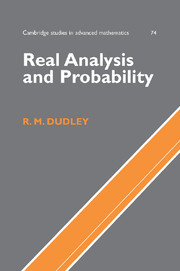Book contents
- Frontmatter
- Contents
- Preface to the Cambridge Edition
- 1 Foundations; Set Theory
- 2 General Topology
- 3 Measures
- 4 Integration
- 5 Lp Spaces; Introduction to Functional Analysis
- 6 Convex Sets and Duality of Normed Spaces
- 7 Measure, Topology, and Differentiation
- 8 Introduction to Probability Theory
- 9 Convergence of Laws and Central Limit Theorems
- 10 Conditional Expectations and Martingales
- 11 Convergence of Laws on Separable Metric Spaces
- 12 Stochastic Processes
- 13 Measurability: Borel Isomorphism and Analytic Sets
- Appendix A Axiomatic Set Theory
- Appendix B Complex Numbers, Vector Spaces, and Taylor's Theorem with Remainder
- Appendix C The Problem of Measure
- Appendix D Rearranging Sums of Nonnegative Terms
- Appendix E Pathologies of Compact Nonmetric Spaces
- Author Index
- Subject Index
- Notation Index
- References
2 - General Topology
Published online by Cambridge University Press: 06 July 2010
- Frontmatter
- Contents
- Preface to the Cambridge Edition
- 1 Foundations; Set Theory
- 2 General Topology
- 3 Measures
- 4 Integration
- 5 Lp Spaces; Introduction to Functional Analysis
- 6 Convex Sets and Duality of Normed Spaces
- 7 Measure, Topology, and Differentiation
- 8 Introduction to Probability Theory
- 9 Convergence of Laws and Central Limit Theorems
- 10 Conditional Expectations and Martingales
- 11 Convergence of Laws on Separable Metric Spaces
- 12 Stochastic Processes
- 13 Measurability: Borel Isomorphism and Analytic Sets
- Appendix A Axiomatic Set Theory
- Appendix B Complex Numbers, Vector Spaces, and Taylor's Theorem with Remainder
- Appendix C The Problem of Measure
- Appendix D Rearranging Sums of Nonnegative Terms
- Appendix E Pathologies of Compact Nonmetric Spaces
- Author Index
- Subject Index
- Notation Index
- References
Summary
General topology has to do with, among other things, notions of convergence. Given a sequence xn of points in a set X, convergence of xn to a point x can be defined in different ways. One of the main ways is by a metric, or distance d, which is nonnegative and real-valued, with xn → x meaning d(xn, x) → 0. The usual metric for real numbers is d(x, y) = ∣x - y∣. For the usual convergence of real numbers, a function f is called continuous if whenever xn → x in its domain, we have f(xn) → f(x).
On the other hand, some interesting kinds of convergence are not defined by metrics: if we define convergence of a sequence of functions fn “pointwise,” so that fn → f means fn(x) → f(x) for all x, it turns out that (for a large enough class of functions defined on an uncountable set) there may be no metric e such that fn→ f is equivalent to e(fn, f) → 0.
Given a sense of convergence, we can call a set F closed if whenever xi ∈ F for all i and xi → x we have x ∈ F also. Any closed interval [a, b] ≔ x: a ≤ x ≤ b is an example of a closed set. The properties of closed sets F and their complements U ≔ X∖F, which are called open sets, turn out to provide the best and most accepted way of extending the notions of convergence, continuity, and so forth to nonmetric situations.
- Type
- Chapter
- Information
- Real Analysis and Probability , pp. 24 - 84Publisher: Cambridge University PressPrint publication year: 2002



